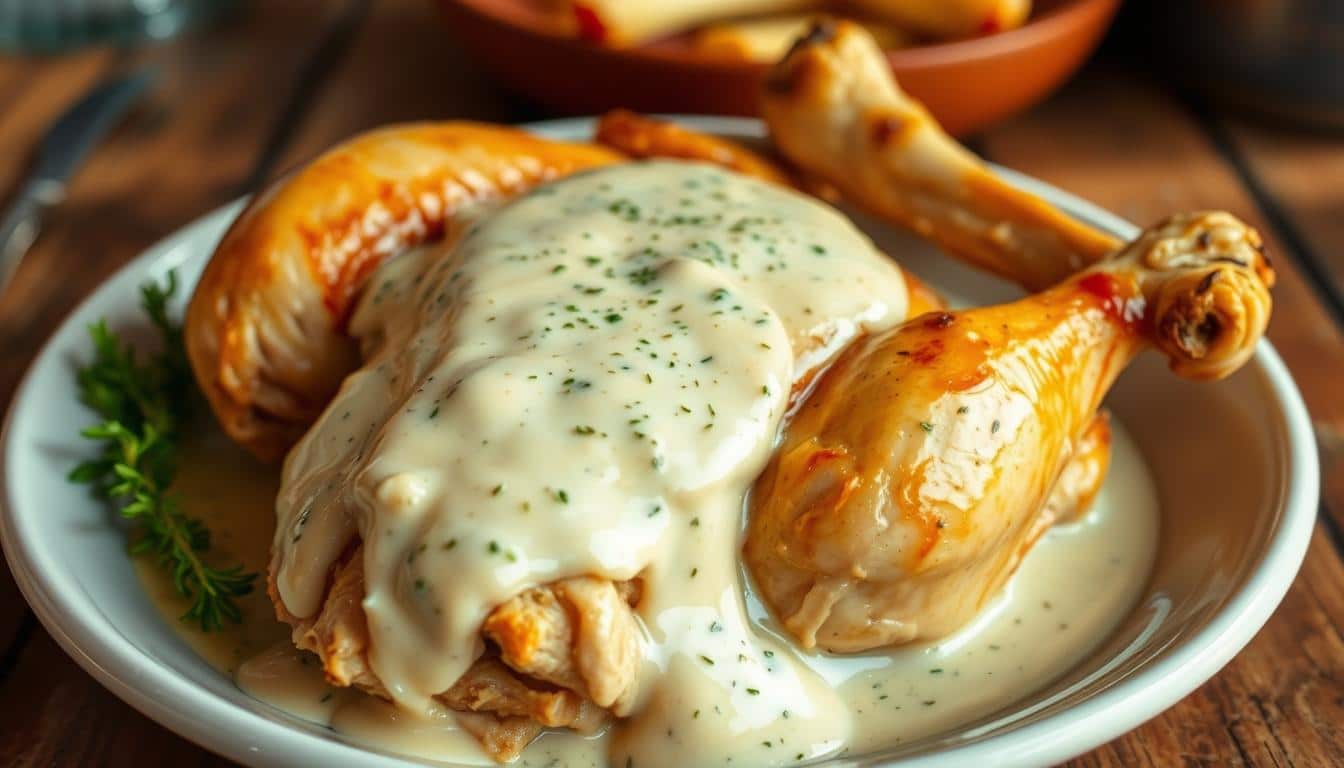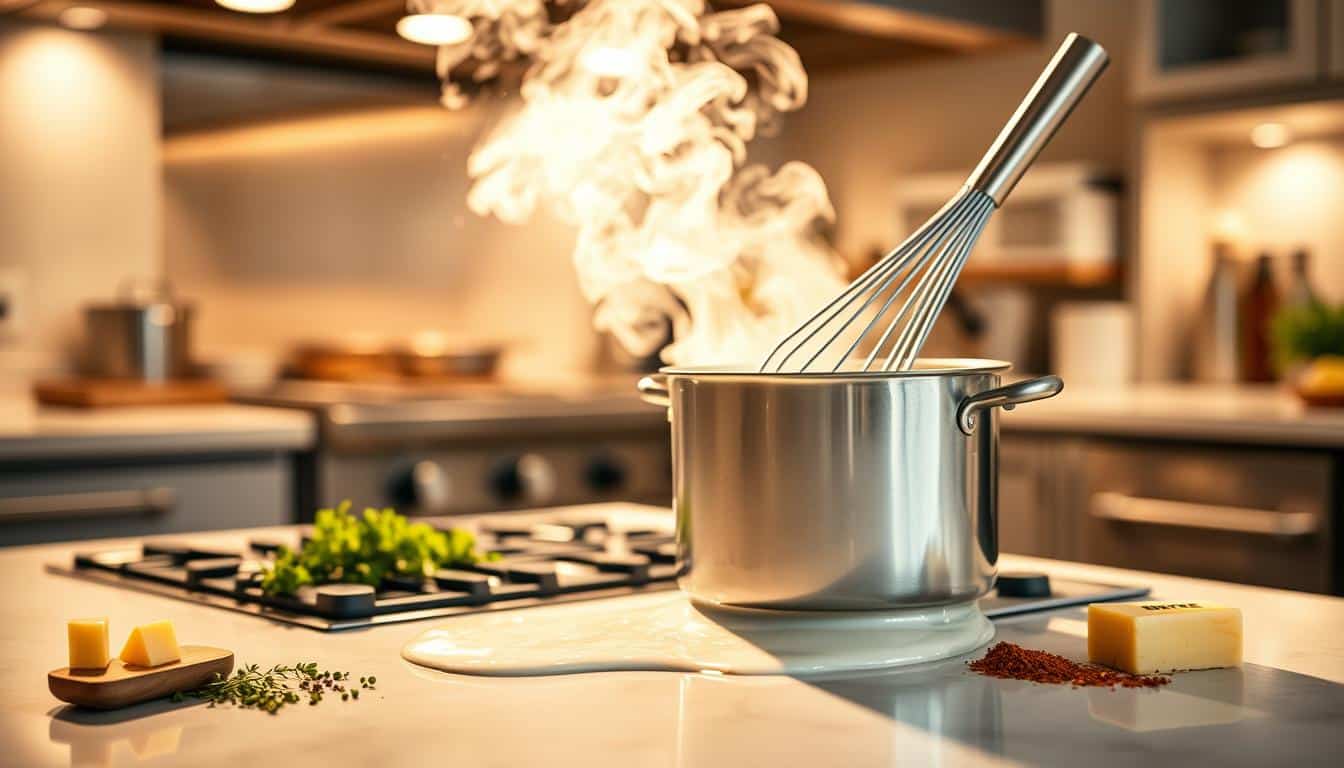Have you ever tasted something so unique that it completely transformed your meal? That’s exactly what happened to me the first time I tried a tangy, creamy, and slightly spicy white sauce on grilled chicken. It was a game-changer. This sauce, rooted in classic BBQ traditions, has become a staple in my kitchen, and I’m excited to share its magic with you.
Thank you for reading this post, don't forget to subscribe!Poulet Alabama White Sauce

Inspired by the legendary Big Bob Gibson’s Bar-B-Q, this Alabama white sauce is more than just a condiment—it’s a flavor enhancer. Whether you’re grilling, smoking, or simply looking to jazz up your weeknight dinners, this sauce brings a tangy kick that pairs perfectly with chicken and other meats. Its versatility and quick preparation make it a must-try for any home cook.
In this article, I’ll walk you through the history, ingredients, and tips to master this sauce. You’ll also discover creative ways to incorporate it into your meals. Let’s dive in and elevate your cooking game!
Key Takeaways
- This sauce is a tangy, creamy blend perfect for grilled or smoked chicken.
- It originated from Big Bob Gibson’s Bar-B-Q in the 1920s.
- The base is mayonnaise, with apple cider vinegar and horseradish for flavor.
- It’s versatile and can be used as a marinade or dipping sauce.
- Preparation takes just 5 minutes, making it a quick meal enhancer.
Discovering the Allure of Alabama White Sauce
Ever stumbled upon a condiment that instantly became your kitchen’s MVP? That’s exactly what happened when I first tried this tangy, creamy blend. It’s not just a sauce—it’s a flavor revolution. From grilled meats to simple sides, it adds a zesty kick that’s hard to resist.
The Story Behind the Sauce
This sauce has a rich history rooted in classic bbq traditions. It was created over 90 years ago by Big Bob Gibson, a legendary pitmaster. His backyard gatherings in the 1920s introduced the world to this unique blend. Inspired by vinegar-based sauces, he added mayonnaise for creaminess and depth.
Today, it’s a staple in northern Alabama, where it’s used on everything from chicken to pork. Its versatility and bold flavor make it a favorite among home cooks and professional chefs alike.
Why It’s a Game-Changer for My Meals
What makes this sauce so special? For starters, it’s incredibly easy to prepare. In just a minute, you can whip up a batch that transforms any dish. Whether you’re grilling, smoking, or roasting, it adds a tangy kick that elevates the flavors.
Here’s a quick comparison of how it enhances different meals:
| Dish | Without Sauce | With Sauce |
|---|---|---|
| Grilled Chicken | Good | Exceptional |
| Pulled Pork | Flavorful | Unforgettable |
| Coleslaw | Basic | Zesty and Creamy |
This sauce has become my secret weapon in the kitchen. It’s not just a condiment—it’s a way to make every meal feel special. Give it a try, and you’ll see why it’s a game-changer.
The Origins and Evolution of Alabama White Sauce
There’s something magical about a condiment that tells a story with every bite. This sauce, with its tangy and creamy profile, has roots deeply embedded in Southern BBQ traditions. It’s more than just a blend of ingredients—it’s a reflection of history and regional pride.

Historical Roots and Regional Influences
The story begins in the 1920s with Big Bob Gibson, a legendary pitmaster from Decatur, Alabama. His backyard gatherings introduced the world to this unique sauce. Inspired by vinegar-based recipes, he added mayonnaise for creaminess and depth. This blend became a staple in Northern Alabama, where it’s used on everything from chicken to pork.
Regional influences played a key role in shaping its flavor. The use of cider vinegar and traditional dry rubs reflects the South’s love for bold, tangy flavors. Over time, this sauce gained popularity beyond Alabama, appearing on menus across the U.S. and even internationally.
How the Recipe Has Adapted Over Time
While the core ingredients remain the same, modern kitchens have adapted the recipe for convenience and versatility. Today, it’s not just a BBQ sauce—it’s a marinade, dressing, and dipping sauce. The emphasis on quality ingredients, like a good rub and fresh cider vinegar, ensures the flavor stays authentic.
For example, pairing this sauce with braised chicken with crispy skin creates a perfect balance of flavors. It’s a testament to how timeless recipes can evolve while staying true to their roots.
In my kitchen, I’ve experimented with adding a hint of spice or using it as a base for coleslaw. These small tweaks keep the recipe exciting and relevant. It’s a reminder that even the most traditional dishes can inspire creativity.
Ingredients and Essential Tools for a Perfect Sauce
Creating the perfect sauce starts with the right ingredients and tools. Each component plays a crucial role in achieving the ideal balance of tang, creaminess, and heat. Let’s break down what you’ll need and why these elements matter.
Core Ingredients and Their Roles
The foundation of this sauce is mayonnaise, which provides a rich, creamy base. Apple cider vinegar adds a tangy kick, while horseradish introduces a subtle spice. A pinch of cayenne brings just the right amount of heat, and a touch of lemon juice brightens the flavor.
Here’s a quick look at how each ingredient contributes:
| Ingredient | Role |
|---|---|
| Mayonnaise | Base for creaminess |
| Apple Cider Vinegar | Adds tangy flavor |
| Horseradish | Provides subtle spice |
| Cayenne | Introduces heat |
Must-Have Kitchen Tools and Equipment
Having the right tools makes all the difference. A sturdy bowl is essential for mixing ingredients evenly. A whisk ensures a smooth consistency, while measuring spoons help maintain the perfect balance of flavors.
Here are my top recommendations:
- A large mixing bowl for easy blending.
- A whisk or fork to combine ingredients thoroughly.
- Measuring spoons for precise amounts of spices and vinegar.
For those looking to expand their sauce repertoire, try pairing this recipe with chicken in tomato sauce. It’s a flavorful combination that’s sure to impress.
With the right ingredients and tools in place, you’re well on your way to mastering this sauce. The key is to balance the tang, creaminess, and heat for a flavor that elevates any dish.
Mastering Poulet Alabama White Sauce Techniques
Perfecting a sauce is all about finding the right balance between tang and creaminess. This unique blend requires attention to detail, especially when it comes to measuring ingredients like juice and salt. Let me walk you through my tried-and-true methods for achieving that signature flavor.

Tips on Balancing Tang and Creaminess
The key to this sauce lies in its balance. Start with a cup of mayonnaise as the creamy base. Then, add apple cider vinegar for tanginess. A splash of lemon juice brightens the flavor, while a pinch of salt enhances the overall taste.
Here’s a quick guide to measurements:
- 1 cup mayonnaise for creaminess.
- 1/4 cup apple cider vinegar for tang.
- 1 tablespoon lemon juice for brightness.
- 1/2 teaspoon salt for seasoning.
These proportions ensure a harmonious blend that’s neither too tangy nor too rich.
My Approach to Achieving Authentic Flavor
Over time, I’ve refined my technique to make this sauce truly stand out. I always use fresh apple cider vinegar for its sharp, clean flavor. Adding a touch of horseradish gives it a subtle kick, while a hint of cayenne brings warmth.
One of my favorite ways to use this sauce is with a whole chicken with Alabama white sauce. The combination of smoky meat and tangy creaminess is unbeatable.
Experimenting with small tweaks, like adjusting the amount of lemon juice or salt, can help you customize the flavor to your liking. The goal is to create a sauce that’s both rich and refreshing.
Grilling and Smoking Methods for Ultimate Flavor
Grilling and smoking are more than just cooking methods—they’re an art form. The way you manage heat and timing can make or break the flavor of your meal. Whether you’re working with chicken, pork, or other meats, understanding these techniques is key to achieving delicious results.
Direct Versus Indirect Heat: When and Why
Direct heat is perfect for searing and crisping the exterior of your meat. It’s ideal for cuts like chicken thighs or pork chops that benefit from a quick, high-temperature cook. On the other hand, indirect heat is your go-to for slow cooking. It ensures the meat cooks evenly without burning, making it great for larger cuts like a whole chicken or pork shoulder.
Here’s a quick comparison:
- Direct Heat: Best for searing and quick cooks.
- Indirect Heat: Ideal for slow, even cooking.
Timing and Temperature Considerations
Timing and temperature are critical for achieving the perfect flavor and texture. For smoked chicken, aim for a smoker temperature of 250-275°F. This ensures the meat cooks thoroughly without drying out. The internal temperature should reach 175°F for tender, juicy results.
Here are my top tips:
- Set your grill or smoker to the right temperature before adding the meat.
- Use a meat thermometer to monitor the internal temperature.
- Allow extra time if you’re frequently opening the smoker lid.
For more advanced techniques, check out this slow-grilled beef ribs guide. It’s packed with tips to elevate your grilling game.
Serving Suggestions and Creative Pairings
Looking for ways to elevate your next meal? This tangy, creamy sauce is your answer. Whether you’re hosting a barbecue or preparing a weeknight dinner, it’s the perfect addition to your table. Let’s explore some creative ways to serve and pair it.
Ideas for Complementary Side Dishes
Pairing this sauce with the right sides can take your meal to the next level. For a classic barbecue, try it with coleslaw. The tanginess of the sauce complements the crunch of the cabbage perfectly. Another great option is a pasta salad. Toss it with fresh veggies and a drizzle of the sauce for a zesty twist.
If you’re serving split chicken, consider grilled vegetables like zucchini or asparagus. The smoky flavor of the veggies pairs beautifully with the creamy sauce. For a lighter option, use it as a dipping sauce for fresh veggies or even fries.
Presentation Tips to Impress Your Guests
Presentation is key to making your meal memorable. Start by arranging your split chicken or grilled meats on a large platter. Drizzle the sauce over the top or serve it in a small bowl on the side. Garnish with fresh herbs like parsley or chives for a pop of color.
For a creative touch, mix prepared horseradish and cider vinegar into the sauce to create a unique dipping blend. Serve it alongside a charcuterie board or as a dressing for a fresh green salad. The possibilities are endless!
If you’re looking for more inspiration, check out these creative uses for Alabama White Sauce. It’s a great resource for exploring new ways to enjoy this versatile condiment.
Troubleshooting Common Issues and Enhancing Your Recipe
Sometimes, even the best recipes need a little troubleshooting. Whether your sauce is too tangy, too thick, or just not spicy enough, small adjustments can make a big difference. Let’s dive into some common challenges and how to fix them.
Adjusting Seasonings and Consistency
Balancing flavors is key to a great sauce. If it’s too tangy, add a teaspoon of sugar to mellow it out. For more heat, mix in a pinch of cayenne or a dash of hot sauce. Always taste as you go to avoid over-seasoning.
If the consistency is too thick, add a splash of cup apple cider vinegar or water. Whisk thoroughly to ensure a smooth texture. For a creamier blend, mix in an extra tablespoon of mayonnaise.
Here’s a quick guide to fixing common issues:
| Issue | Solution |
|---|---|
| Too Tangy | Add 1 teaspoon sugar |
| Too Thick | Mix in 1-2 tablespoons cup apple cider vinegar |
| Not Spicy Enough | Add a pinch of cayenne or hot sauce |
Storage Tips for Leftover Sauce
To keep your sauce fresh, store it in an airtight container in the refrigerator. It will last up to a week. If you’ve used it with whole chicken, make sure the sauce hasn’t come into contact with raw meat to avoid contamination.
For longer storage, freeze the sauce in small portions. Thaw it in the fridge overnight before use. Stir well to restore its smooth consistency.
By mastering these adjustments, you can ensure your sauce is always perfect. Whether you’re serving it with whole chicken or using it as a dip, these tips will elevate your recipe every time.
Conclusion
This tangy, creamy blend has become a staple in my kitchen for its versatility and bold flavor. From enhancing a whole bird to elevating sliced breast dishes, it’s a game-changer for any meat lover. The key lies in precise measurements—whether it’s a cup apple cider vinegar or a tablespoon of lemon juice—to achieve the perfect balance.
I’ve found it pairs beautifully with chicken, turkey, and even pork, adding a zesty kick to every bite. Don’t be afraid to experiment with your own variations. A little tweak here or there can make it uniquely yours.
With the right technique and quality ingredients, this recipe is easy to recreate at home. Give it a try, and you’ll see why it’s a must-have in your culinary arsenal.
FAQ
What makes this sauce unique compared to other barbecue sauces?
Can I use this sauce on meats other than chicken?
How long should I marinate the chicken for the best results?
Can I make this sauce ahead of time?
What’s the best way to grill chicken with this sauce?
How can I adjust the spiciness of the sauce?
What sides pair well with this dish?
Can I freeze the leftover sauce?
What’s the key to balancing the tang and creaminess?
How do I prevent the sauce from burning on the grill?
There are no reviews yet. Be the first one to write one.
